Easy Truck Drawings Easy Motorcycle Yamaha Crochrocket Drawings
Section Three: The Basic styles of Motorcycles
| < Back | Beginners Guide to Motorcycling Index | Next > | ||
| Section 1 | Section 1.5 | Section 2 | Section 2.5 | Section 3 |
| Section 4 | Section 5 | Section 5.5 | Section 6 | Section 6.5 |
| Section 6.75 | Section 7 | Section 8 | Section 9 | Appendix 1 |
| Appendix 2 | Appendix 3 | |||
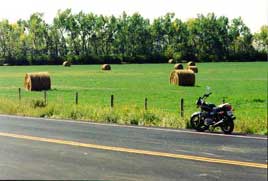 So many different bikes to choose from, where do you start? Honda, Suzuki, Kawasaki, Yamaha, Harley, Triumph, BMW they all make the right bike for you, and this section will help you find out what that "right bike" is!
So many different bikes to choose from, where do you start? Honda, Suzuki, Kawasaki, Yamaha, Harley, Triumph, BMW they all make the right bike for you, and this section will help you find out what that "right bike" is!
Have fun out there, enjoy the ride and be safe. – Mike Le Pard (webmaster)
The Basic styles of Motorcycles
– Standard/Naked/Traditional/Muscle Bike/Commuter
– Cruiser/Custom/Choppers/Muscle Cruiser
– Sport Bike/Crotch Rocket/Super Sport/Hyper Sport
– Sport Touring/Performance Tourer/Cruiser Tourer
– Touring/Luxury Touring
– Dual Sport/Dual Purpose
– Dirt Bike/Off-Road Bike
Standard/Naked/Traditional/Muscle Bike/Commuter:
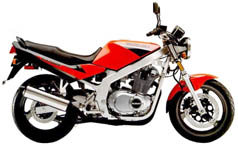
Foot pegs and shifter are located almost (either a little forward, directly below or a little rear-ward) below the waist in a "natural" style which creates a very comfortable, ergonomic upright seating position. Handlebars define the upright riding style and are designed not to put pressure on the wrists or tailbone.This style has a no holds bar look, exposed 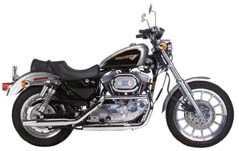 engine, and long seat, with minimal plastic, small or no fairing. They are purpose built to cover a wide area of riding situations. With clean, uncluttered lines and versatile designs, they offer unbeatable riding enjoyment. Standard/Naked/Traditional motorcycles balance performance and practicality, comfort and convenience, and all at low prices.
engine, and long seat, with minimal plastic, small or no fairing. They are purpose built to cover a wide area of riding situations. With clean, uncluttered lines and versatile designs, they offer unbeatable riding enjoyment. Standard/Naked/Traditional motorcycles balance performance and practicality, comfort and convenience, and all at low prices.
Standard/Naked/Traditional Motorcycles are the most "customable" do it all designs that a rider can change into a proficient sport bike (tune up kits, jetting, performance hardware), dirt bikes (knobby tires, dirt bike suspension), cruiser (custom paint jobs, added chrome, side bags, windshield) or even a touring bike (windshield, side bags, trunk/tank bag, Corbin seat). 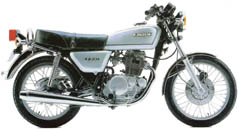
Standard/Naked/Traditional Motorcycles have appeal worldwide and are available from 50cc – 1300+cc sizes; single-cylinder, inline twin, inline triple, inline four, V2 (vee-two), V4 (vee-four), boxer (2 180 degree pistons) engines from countless manufacturers worldwide. Thus the engine does not define the particular style of bike other than being exposed.
A "new" variation of the Standard/Naked/Traditional style is the Muscle Bike, and the commuter. The difference between these two styles is the Muscle Bike is a 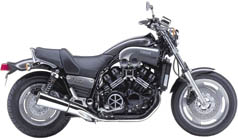 Standard/Naked/Traditional bike with the biggest, most powerful, torque filled engine they could fit into the frame to produce adrenaline en-masse. The commuter is a mostly basic very small engine bike, highly fuel efficient around town bike, similar to a moped or scooter but using the Standard/Naked/Traditional riding position.
Standard/Naked/Traditional bike with the biggest, most powerful, torque filled engine they could fit into the frame to produce adrenaline en-masse. The commuter is a mostly basic very small engine bike, highly fuel efficient around town bike, similar to a moped or scooter but using the Standard/Naked/Traditional riding position.
While the Standard/Naked/Traditional motorcycle category has been around longer than any another other category and almost all motorcycle designs started out first as this type. The Standard/Naked/Traditional style of design was threatened to disappear in the late 1980's and early 90's with the overwhelming popularity of the cruiser and sport bike styles. Today, manufacturers are again offering the Standard/Naked/Traditional style of motorcycles.
The Standard/Naked/Traditional style is 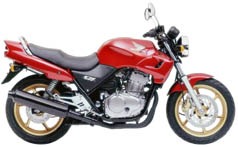 one of the easiest types to learn on for new bikers (other than dual-sport) and highly recommended to start on. All the controls are right where you think they should be, they have good balance and weight distribution (generally a lighter weight and not top heavy) and do not cost a lot to repair in case of a drop or spill (due to the lack of expensive plastic and chrome). Has the unique ability to be converted into anything the rider wants, quickly, easily and cheaply and be able to do that job proficiently.
one of the easiest types to learn on for new bikers (other than dual-sport) and highly recommended to start on. All the controls are right where you think they should be, they have good balance and weight distribution (generally a lighter weight and not top heavy) and do not cost a lot to repair in case of a drop or spill (due to the lack of expensive plastic and chrome). Has the unique ability to be converted into anything the rider wants, quickly, easily and cheaply and be able to do that job proficiently.
Cruiser/Custom/Choppers/Muscle Cruiser:
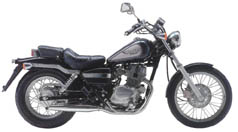 Foot pegs and shifter are located either set a little forward (mostly on older design cruisers/customs) or very forward so your legs can stretch out to the front side of the engine. The riding position can be comfortable or be a badly designed torture device with too much weight being placed on the tailbone. Handlebars define the laid back riding style and are designed to stretch the arms out. In the case of a Cruiser, they style/look sometimes goes before almost everything else, if this is important to you, a Cruiser is worth consideration. This style has a "bad boy" look, exposed engine, custom seat, with minimal plastic, small or no fairing and loads of chrome. In fact on some Cruisers/Customs the chrome and accessories can be as heavy as the engine itself. They are style/looks built and are designed to a boulevard cruising lean mean custom machine. Another good role they play is in the touring motorcycle scene due to their laid back, comfortable ride (on some).
Foot pegs and shifter are located either set a little forward (mostly on older design cruisers/customs) or very forward so your legs can stretch out to the front side of the engine. The riding position can be comfortable or be a badly designed torture device with too much weight being placed on the tailbone. Handlebars define the laid back riding style and are designed to stretch the arms out. In the case of a Cruiser, they style/look sometimes goes before almost everything else, if this is important to you, a Cruiser is worth consideration. This style has a "bad boy" look, exposed engine, custom seat, with minimal plastic, small or no fairing and loads of chrome. In fact on some Cruisers/Customs the chrome and accessories can be as heavy as the engine itself. They are style/looks built and are designed to a boulevard cruising lean mean custom machine. Another good role they play is in the touring motorcycle scene due to their laid back, comfortable ride (on some). 
Cruisers/Customs are the pinnacle of "customable" motorcycles in their looks. They look good standing still, look good cruising the highways and look good in magazines. In fact, almost anyone would look good sitting on one. With acres of chrome and accessories available (and imaginable) you can make a cruiser look anyway you want it to and still have it look different in its own way.
The Cruisers/Customs motorcycle category has been around a very long time but they have changed and evolved their style as time progressed and almost every decade has its own "look". Since the late 1970's the manufacturers started to get into the Cruiser/Custom building business and as time marched on, today Cruisers/Customs represent a huge part of the market. While it is ironic to say a manufacturer can mass reproduce a Cruisers/Customs and call it that it was not that way in the past. Cruisers/Customs were one of, unique machines with many parts hand made. 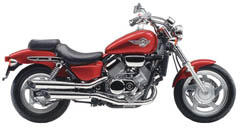 Choppers are another variation of the Cruiser/Custom style, but with huge raked out front forks, banana seats and with the idea of cutting everything off the bike that didn't need to be they're for the sake of personal style (even the front brake). I would now assume you understand how important the style/look department is. Power Cruisers/Customs are the same as type as the "normal" Cruiser/Custom style except the Muscle bike, they as well stick a very large engine into the frame but that engine usually comes from a Muscle bike or a Sport Bike. Most Cruiser/Custom bikes carry the V-twin (vee-twin) engine design for maximum torque at low RPMs, and these engines produce a sound that rival the Cruiser/Custom looks all at the cost of top speed and horsepower. Engine sizes are from 50cc to monster 1800cc. Because of their looks and engine sound they can be as much fun putting around town in as they are looking at parked in front of a diner or the side of the street.
Choppers are another variation of the Cruiser/Custom style, but with huge raked out front forks, banana seats and with the idea of cutting everything off the bike that didn't need to be they're for the sake of personal style (even the front brake). I would now assume you understand how important the style/look department is. Power Cruisers/Customs are the same as type as the "normal" Cruiser/Custom style except the Muscle bike, they as well stick a very large engine into the frame but that engine usually comes from a Muscle bike or a Sport Bike. Most Cruiser/Custom bikes carry the V-twin (vee-twin) engine design for maximum torque at low RPMs, and these engines produce a sound that rival the Cruiser/Custom looks all at the cost of top speed and horsepower. Engine sizes are from 50cc to monster 1800cc. Because of their looks and engine sound they can be as much fun putting around town in as they are looking at parked in front of a diner or the side of the street.
If this style of motorcycle appeals to you, then you are in luck! Cruiser/Custom motorcycles are in big demand (and generate big sales) today. Almost every manufacturer offers not just one but many styles and sizes to fit you and your budget. Even so, Cruisers/Customs are almost exclusively an American/Canadian market but are sold worldwide in smaller quantities. 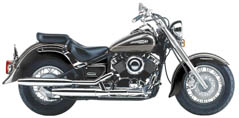
The Cruiser/Custom style is not one of the easiest types to learn on for new bikers but if you want to ride one then you have no choice. The foot peg and shifter position, combined with the laid back seating position and higher up handle bars can be a challenge for new riders to master. The good graces that save them, as a training bike is the low seat height so even the shortest riders can ride one and touch the ground easily. Even though I personally would not recommend this bike to learn on as the cost of repair in case of a drop or spill (due to the quality and amount of expensive chrome) also most! Cruiser/Custom bikes are V twins (vee-twin) engine design that produce massive amount of torque quickly at low RPMs.
Sport Bike/Crotch Rocket/Super Sport/Hyper Sport:

Foot pegs and shifter are located (either a little rear-ward or very rear-ward) rearward from the waist in an "aggressive" riding style which creates a very streamlined, aerodynamic and quicker reflex seating position. Handlebars define the "aggressive" riding position and are designed to bend the human rider into the streamlined, aerodynamic shape of the bike and utilize the quick steering nature of the motorcycle. This riding position can put pressure on the wrists, and can be uncomfortable for long rides. This style has a jet fighter look, hidden engine, and short seat, with loads of streamlined, aerodynamic plastic sculpted in a wind tunnel and integrated fairing. They are purpose for speed, racing and going fast around corners (and looking good while doing it). They even look like they are going Warp 10 standing still.
 Sport Bike/Crotch Rocket Motorcycles are designed to be fast, quick and agile. Sport Bikes combine leading-edge engine design and chassis technology. They are molded after racing track motorcycles and feature the latest and greatest (sometimes unproven) technology such as: state-of-the-art multicylinder engine designs; aluminum alloy frames; ultra-sophisticated adjustable suspension to put them ahead of their competition (other Sport Bike/Crotch Rocket manufacturers). Almost every manufacturer carries several different versions of Sport Bikes/Crotch Rockets from small (250cc) learners up to massive (1300cc) rocket ships. While a Sport Bike/Crotch Rocket can be made into a touring bike or commuter, their true home is on the racetrack or fast curve filled roads. Unfortunately, Sport Bike/Crotch Rocket style bikes represent a high number of bike accidents.
Sport Bike/Crotch Rocket Motorcycles are designed to be fast, quick and agile. Sport Bikes combine leading-edge engine design and chassis technology. They are molded after racing track motorcycles and feature the latest and greatest (sometimes unproven) technology such as: state-of-the-art multicylinder engine designs; aluminum alloy frames; ultra-sophisticated adjustable suspension to put them ahead of their competition (other Sport Bike/Crotch Rocket manufacturers). Almost every manufacturer carries several different versions of Sport Bikes/Crotch Rockets from small (250cc) learners up to massive (1300cc) rocket ships. While a Sport Bike/Crotch Rocket can be made into a touring bike or commuter, their true home is on the racetrack or fast curve filled roads. Unfortunately, Sport Bike/Crotch Rocket style bikes represent a high number of bike accidents.
 Sport Bike/Crotch Rocket style motorcycles have appeal worldwide and are available from 50cc – 1300+cc sizes; single-cylinder, inline twin, inline triple, inline four, V2 (vee-two), V4 (vee-four), boxer (2 180 degree pistons) engines from countless manufacturers worldwide. Unlike the Standard/Naked/Traditional category the engine does define this particular style of bike by being engineered to produce the most horsepower (HP) for the size, while being the lightest it can be. Most Sport Bike/Crotch Rocket engines are the inline four type due to the inline four engine's ability to run at very high (14,000+RPM) and do it smoothly versus other types of engines.
Sport Bike/Crotch Rocket style motorcycles have appeal worldwide and are available from 50cc – 1300+cc sizes; single-cylinder, inline twin, inline triple, inline four, V2 (vee-two), V4 (vee-four), boxer (2 180 degree pistons) engines from countless manufacturers worldwide. Unlike the Standard/Naked/Traditional category the engine does define this particular style of bike by being engineered to produce the most horsepower (HP) for the size, while being the lightest it can be. Most Sport Bike/Crotch Rocket engines are the inline four type due to the inline four engine's ability to run at very high (14,000+RPM) and do it smoothly versus other types of engines.
A variation of the Sport Bike/Crotch Rocket style is the Super Sport and Hyper Sport Bike. The difference between these and the Sport Bike/Crotch Rocket styles is the Super Bike is a Sport bike with the handle bars clipped on below the triple tree (mounted much lower than normal sport bike bars) and are more extreme in rider position, lighter in weight as well as having much more engine HP. They are almost direct descendants of the racetrack bike that is currently used in the  professional race circuit. As a side note, some Sport Bike/Crotch Rocket bikes will have some of these features, but will not be as directly related to the professional race circuit bikes as these are.
professional race circuit. As a side note, some Sport Bike/Crotch Rocket bikes will have some of these features, but will not be as directly related to the professional race circuit bikes as these are.
The Sport Bike/Crotch Rocket motorcycle category has been around for a long time since people have been racing motorcycles since they were first made. In the early days, a 1000cc sport bike might have produced 12HP; today a 1000cc sport bike can easily be 10 times that. With the overwhelming popularity of the sport bike styles you will not find it hard to find a bike that suits your needs, style of riding, and power requirements. Motorcycle manufacturers have long known that a win on the racetrack means big sales on the show room floor.
 Sport Bike/Crotch Rocket motorcycles are fun to ride and the style of the moderate ones (EX500, Ninja 250) is easy to learn on for new bikers. All the controls are right where you think they should be, they have good balance and weight distribution (generally a lighter weight) and the foot pegs are in a better position to put your foot down quickly than on the cruiser. Unfortunately, they also have a large draw that they can be expensive to repair in case of a drop or spill (due to the amount of expensive plastic).
Sport Bike/Crotch Rocket motorcycles are fun to ride and the style of the moderate ones (EX500, Ninja 250) is easy to learn on for new bikers. All the controls are right where you think they should be, they have good balance and weight distribution (generally a lighter weight) and the foot pegs are in a better position to put your foot down quickly than on the cruiser. Unfortunately, they also have a large draw that they can be expensive to repair in case of a drop or spill (due to the amount of expensive plastic).
Sport Touring/Performance Tourer/Cruiser Tourer:
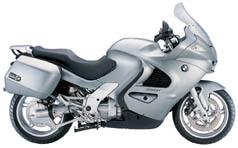
Foot pegs and shifter are located almost (either a little forward, directly below or a little rear-ward) below the waist in a "natural" style which creates a very comfortable, ergonomic upright seating position just like that of a standard/traditional motorbike. Handlebars define the upright riding style and are designed not to put pressure on the wrists or tailbone. Like the Sport Bike, they are more oriented for performance riding, and are more aerodynamic and streamlined as well than regular touring bikes.
What is the different between a Performance Tourer and a Luxury Tourer? Simply that the Luxury tourer may not have such a performance oriented engine, sleek looking body type, aerodynamic fairings, or be as light in total weight. But also the Performance Tourer may not have such a smooth oriented engine, have all the super luxury items, super comfort for two, the large storage space, or be as heavy in total weight. A Luxury Tourer is more oriented towards comfort, amenities and distance riding while the Performance Tourer toward speed, agility and lighter weight. A Cruiser Touring bike falls in between both offering neither the comforts of a Luxury Tourer or the abilities of a Performance tourer, but to make us for this, tries to offer more style/looks than either.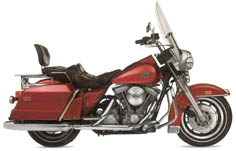
Almost all touring bikes (performance or regular) carry luxury features like windscreens, luggage bags (hard or soft), highly comfortable seat (for both rider and passenger), larger gas tanks and shaft drive. The Cruiser touring bike rather than being a sport bike/touring bike mix is more a cruiser/touring bike mix. Therefore, the Cruiser Tourer can share many of the Cruiser features like foot peg position, handle bars and seating position but is designed to make that even more comfortable for long rides.
Performance Tourer/Cruiser Tourer Motorcycles are very "customable" to make touring even more luxurious, comfortable and home like in a sporty way. With manufacturers and after-market companies offering adjustable windshields, side bags, trunk/tank bags, Corbin seats, heated grips, CD stereos, CB systems, GPS units, cruise control, passenger arm rests, cup holders, custom chrome pieces and so much more. If long distance touring with some road curves is in your heart, this is the bike for you.
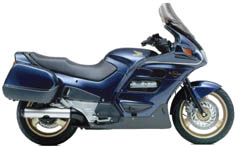 Performance Tourer motorcycles has appeal worldwide (Cruiser Tourer less so) and is available in large 500cc – 1800+cc engine sizes and the majority of them are inline four, V2 (vee-two), V4 (vee-four), boxer (2, 4 or 6 180 degree pistons) engines. The Boxer 4 and 6 being the most smooth of them all. Thus the engine does help define the particular style of bike (being smooth and powerful) but also the aerodynamic and streamlined fairings and performance parts help define it as well.
Performance Tourer motorcycles has appeal worldwide (Cruiser Tourer less so) and is available in large 500cc – 1800+cc engine sizes and the majority of them are inline four, V2 (vee-two), V4 (vee-four), boxer (2, 4 or 6 180 degree pistons) engines. The Boxer 4 and 6 being the most smooth of them all. Thus the engine does help define the particular style of bike (being smooth and powerful) but also the aerodynamic and streamlined fairings and performance parts help define it as well.
People have been touring on motorcycles for a very long time. It is only natural that some of those riders wanted to tour but also do more performance oriented riding as well. What we have today in the Performance Tourer style is the accumulation of decades of improvements to standard motorcycles (with the appropriate mixture of industry profit). Performance Touring motorcycles are popular with those who enjoy sport bike power and handling but want to go further in their motorcycle travels. And while the Performance Tourer is not as agile or flick able as the sport bike it is a great compromise.
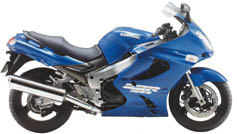 The Performance Tourer style is not one of the easiest types to learn on for new bikers. All the controls are right where you think they should be, they have average balance and weight distribution and can be top heavy, hard to control at slow speeds, large in size and like a sport bike they cost a lot to repair in case of a drop or spill (due to the amount of expensive plastic and chrome). Because these bikes are built for distance riding they carry engines that are large in capacity (minimum of 500cc) and can be harder to learn on as well because of this. Personally, I would recommend starting off with a Standard style of motorcycle and build it up for long distance touring (windshield, extra comfy seat, touring bags, etc).
The Performance Tourer style is not one of the easiest types to learn on for new bikers. All the controls are right where you think they should be, they have average balance and weight distribution and can be top heavy, hard to control at slow speeds, large in size and like a sport bike they cost a lot to repair in case of a drop or spill (due to the amount of expensive plastic and chrome). Because these bikes are built for distance riding they carry engines that are large in capacity (minimum of 500cc) and can be harder to learn on as well because of this. Personally, I would recommend starting off with a Standard style of motorcycle and build it up for long distance touring (windshield, extra comfy seat, touring bags, etc).
Touring/Luxury Touring:
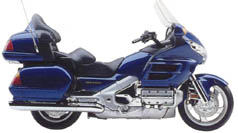
Foot pegs and shifter are located almost (either a little forward, directly below or a little rear-ward) below the waist in a "natural" style which creates a very comfortable, ergonomic upright seating position just like that of a standard/traditional motorbike. Handlebars define the upright riding style and are designed not to put pressure on the wrists or tailbone. Like a motor home, they are more oriented for comfort, amenities and distance riding than performance or cruiser touring bikes.
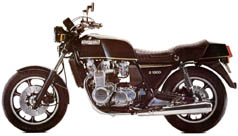 What is the different between a Luxury Tourer and a Performance Tourer? Simply that the Performance tourer will/may not have such a smooth oriented engine, have all the super luxury items, super comfort for two, the large storage space, or be as heavy in total weight. But also the Luxury Tourer may not have such a performance oriented engine, sleek looking body type, aerodynamic fairings, or be as light in total weight. A Luxury Tourer is more oriented towards comfort, amenities and distance riding while the Performance Tourer toward speed, agility and lighter weight. A Cruiser Touring bike falls in between both offering neither the comforts of a Luxury Tourer or the abilities of a Performance tourer, but to make us for this, tries to offer more style/looks than either.
What is the different between a Luxury Tourer and a Performance Tourer? Simply that the Performance tourer will/may not have such a smooth oriented engine, have all the super luxury items, super comfort for two, the large storage space, or be as heavy in total weight. But also the Luxury Tourer may not have such a performance oriented engine, sleek looking body type, aerodynamic fairings, or be as light in total weight. A Luxury Tourer is more oriented towards comfort, amenities and distance riding while the Performance Tourer toward speed, agility and lighter weight. A Cruiser Touring bike falls in between both offering neither the comforts of a Luxury Tourer or the abilities of a Performance tourer, but to make us for this, tries to offer more style/looks than either.
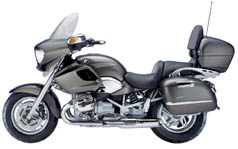 Almost all touring bikes (performance or regular) carry luxury features like windscreens, luggage bags (hard or soft), highly comfortable seat (for both rider and passenger), larger gas tanks and shaft drive. Tourer Motorcycles are very "customable" to make touring even more luxurious than they already are. Offering supreme comfort with manufacturers and after-market companies offering adjustable windshields, side bags, trunk/tank bags, Corbin seats, heated grips, CD stereos, CB systems, GPS units, cruise control, passenger arm rests, cup holders, custom chrome pieces and so much more. If long distance touring over a very long distance in comfort is in your heart, this is the bike for you.
Almost all touring bikes (performance or regular) carry luxury features like windscreens, luggage bags (hard or soft), highly comfortable seat (for both rider and passenger), larger gas tanks and shaft drive. Tourer Motorcycles are very "customable" to make touring even more luxurious than they already are. Offering supreme comfort with manufacturers and after-market companies offering adjustable windshields, side bags, trunk/tank bags, Corbin seats, heated grips, CD stereos, CB systems, GPS units, cruise control, passenger arm rests, cup holders, custom chrome pieces and so much more. If long distance touring over a very long distance in comfort is in your heart, this is the bike for you.
Tourer motorcycles have appeal worldwide while Luxury Touring is less so outside North America. Tourer motorcycles are available in any engine sizes and engine configuration; in fact a standard style motorcycle can be modified into the touring motorcycle category. Luxury Touring bikes are built on comfort so only the largest, smoothest engines will do and the majority of them are inline four, V2 (vee-two), V4 (vee-four), boxer (2, 4 or 6 180 degree pistons) engines. The Boxer 4 and 6 being the most smooth of them all. Thus the engine does help define the Luxury Touring style of bike (being smooth and powerful) more than the Performance Touring bike but also the amenities and luxuries as well.
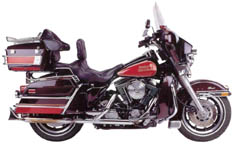 People have been touring on motorcycles for a very long time. It is only natural that some of those riders wanted to go further and further with their motorcycles so they brought what they felt was comfort with them. What we have today in the Luxury Tourer style is the accumulation of decades of improvements to standard motorcycles (with the appropriate mixture of industry profit). Luxury Touring motorcycles is popular with those who enjoy traveling very long distances and want supreme comfort doing it as well. The Luxury Tourer is the ultimate in comfort, luxuries, convenience and accessories by a long shot.
People have been touring on motorcycles for a very long time. It is only natural that some of those riders wanted to go further and further with their motorcycles so they brought what they felt was comfort with them. What we have today in the Luxury Tourer style is the accumulation of decades of improvements to standard motorcycles (with the appropriate mixture of industry profit). Luxury Touring motorcycles is popular with those who enjoy traveling very long distances and want supreme comfort doing it as well. The Luxury Tourer is the ultimate in comfort, luxuries, convenience and accessories by a long shot.
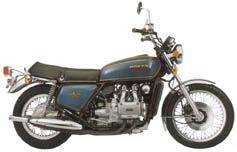 The Luxury Tourer style is definitely not one of the easiest types to learn on for new bikers. While all the controls are right where you think they should be, they have at best average balance and weight distribution and easily can be top heavy as well as being hard to control at slow speeds. Their extra large size and weight make some of them need a special reverse gear. They cost a lot to repair in case of a drop or spill (due to the amount of expensive plastic and chrome). Because these bikes are built for very long distance riding they carry engines that are large in capacity and can be harder to learn on as well because of this. Personally, I would recommend starting off with a Standard style of motorcycle and build it up for long distance touring (windshield, extra comfy seat, touring bags, etc).
The Luxury Tourer style is definitely not one of the easiest types to learn on for new bikers. While all the controls are right where you think they should be, they have at best average balance and weight distribution and easily can be top heavy as well as being hard to control at slow speeds. Their extra large size and weight make some of them need a special reverse gear. They cost a lot to repair in case of a drop or spill (due to the amount of expensive plastic and chrome). Because these bikes are built for very long distance riding they carry engines that are large in capacity and can be harder to learn on as well because of this. Personally, I would recommend starting off with a Standard style of motorcycle and build it up for long distance touring (windshield, extra comfy seat, touring bags, etc).
Dual Sport/Dual Purpose:
Foot pegs and shifter are located below the waist in a "natural" style which creates a very comfortable, ergonomic upright seating position. Handlebars define the upright riding style they are designed for easier slow speed turning and to not put pressure on the wrists. This style has a basic look, exposed engine, long seat, light weight, minimal plastic, higher seat height, long suspensions, and usually no fairing. They are purpose built to cover a very wide area of riding situations anywhere in the world on any riding surface. With clean, uncluttered lines, legal riding gear (headlight, turn signals, mirrors) and versatile designs, they offer unbeatable riding enjoyment in both dirt and asphalt. Dual-Sport motorcycles are designed to perform better than a street bike in the dirt and better than a dirt bike on the street and give you a chance to do both equally well. Since there are more off road riding opportunities in the world than on-road Dual-Sport bikes make highly sensible motorcycles. Extreme versatility, performance, practicality, comfort and convenience, and all at low prices.
Dual-Sport Motorcycles have appeal worldwide and are available from 50cc – 650+cc sizes. The majority of Dual-Sports are single-cylinder engines because of the simplicity of the design and that single-cylinder engines produce high amount of torque. A few Dual-Sports are V2 (vee-two), and boxer (2 180 degree pistons) engines as well and all are from countless manufacturers worldwide. Thus the engine (single-cylinder) does help define the particular style of bike other than being exposed and looking like a dirt bike in many ways.
A "new" variation of the Dual-Sport style is the Adventure Bike. The difference between these two styles is the Adventure is a Dual-Sport bike with a bigger, more powerful, torque filled engine, larger carrying capacity, more lights and heavier mass. They are popular for taking on the really rough wilderness and jungles around the world where more torque and carrying capacity is needed. While the Adventure version sounds different it is really just an oversized and more dirt/dual-sport type of dual-sport.
The Dual-Sport category is relatively new starting in the 1970's with the dirt bikes being added with road safety gear and small standard bikes adding dirt tires and longer travel suspensions. People soon realized that you could now ride to the dirt track/roads/forest paths and ride back along normal roads without having to tow the bike around on a truck (like you do a dirt bike) and it saved them time and was much more convenient so they became a success.
The Dual-Sport design is very easy to learn on for new bikers to learn on and highly recommended to start on. All the controls are right where you think they should be, they have good balance and are light in weight. Some drawbacks might be the higher seat height for short riders (Due to having longer travel suspension for the dirt). They do not cost a lot to repair in case of a drop or spill (due to the lack of expensive plastic and chrome). This style will let you ride in anything you want, take you anywhere in the world you want and do it well. It is a compromise design so if you are not going to be doing any dirt riding, get a street bike, if you are not going to be doing any street riding, get a dirt bike; mix of both? You've come to the right place.
Dirt Bike/Off-Road Bike:
Very similar to the Dual-Sport the foot pegs and shifter are located below the waist in a "natural" style that creates a very comfortable, ergonomic upright seating position. Handlebars define the upright riding style they are designed for easier slow speed turning and to not put pressure on the wrists. This style has a very basic look, fully exposed engine, short seat, very light weight, plastic gas tank, minimal or no plastic, higher seat height, long suspensions, large diameter tires, and no fairing. They are purpose built to cover a very wide area of dirt riding situations anywhere in the world on any non-road riding surface. These styles of motorcycles ride in dirt better than anything else and that is where they are most comfortable. Off-Road motorcycles range from weekend trail bikes suitable for the whole family, to specialized Off-Road racing machines designed to handle a wide variety of rough terrain. If dirt riding only is your thing, then this is the style of motorcycle for you.
Off-Highway motorcycles come in two varieties: Motocross and Off-Road models.
Off-Road motorcycles range from weekend trail bikes suitable for the whole family, to specialized Off-Road racing machines designed to handle a wide variety of rough terrain.
Dirt Bike (and Motocross) motorcycles have appeal worldwide and are available in smaller engine sizes from 50cc – 400cc. Since single-cylinder engines are designed to produce high amount of torque a large heavy engine is not needed and takes away from the light, nimble handling. Since Dirt-Bikes and Motocross are specialized styles of motorcycles there are a small amount of manufacturers worldwide that produce them. The engine (single-cylinder) does help define the particular style of bike other than being exposed as well as the "killer-bee" sound the smaller torque filled engines make.
Another variation of the Dirt Bike style is the Motocross Bike. Motocross bikes are built for closed-course competition. The difference between these two styles is the Motocross is a Dirt bike with single-cylinder engines tuned for racing, and suspension systems able to handle motocross tracks. They are popular for dirt track racing and for taking on the really rough terrain at high speeds, but impractical for other uses.
The Dirt Bike/Motocross category is relatively new as well starting in the 1960's with the small standard bikes adding dirt tires and longer travel suspensions. People soon realized that it was really fun riding off road and you could now ride and even race in the dirt/mud/sand/etc. Because the bikes were light, small, cheap to buy and fix and you could take them camping with the kids, the boom sales were on.
Even though the Dirt Bike design is easy for new bikers to learn on, it is not highly recommended to start learning on due to the lack of road safety gears (no mirrors, horn, turn signals etc). The Dual-Sport would be the better choice to start leaning on, unless you just want to learn to ride in the dirt/mud/sand, then the Dirt Bike is IDEAL. With much fewer controls, good balance and a very light in weight kids of all ages will have a fun time riding off road. Some drawbacks might be the higher seat height in the largest of dirt bikes for short riders (Due to having longer travel suspension for the dirt) but this is not a problem for the smaller engine sized ones. They do not cost a lot to repair in case of a drop or spill (due to the lack of expensive plastic and chrome). This style will let you ride off road in anything you want, take you anywhere in the world you want and do it well.
flemminggollond2001.blogspot.com
Source: https://www.totalmotorcycle.com/school-SectionThree
0 Response to "Easy Truck Drawings Easy Motorcycle Yamaha Crochrocket Drawings"
Post a Comment